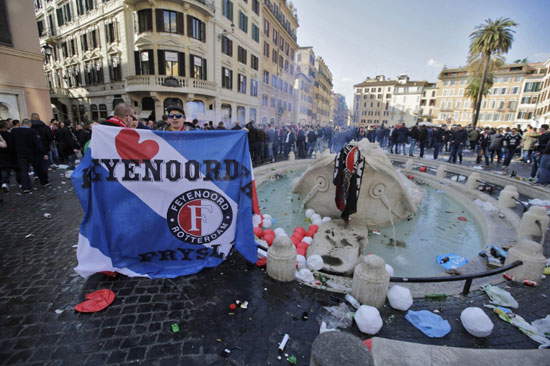The first thing I would like to know about the damage to the Barcaccia in the Spanish Steps, a fundamental masterpiece by Pietro and Gian Lorenzo Bernini, is what kind of consideration the quaestor of Rome Nicolò D’Angelo has for art. Far be it from me to advance any kind of conclusion about the work of the police, although it is more than legitimate, indeed perhaps it is a duty, to wonder for what absurd reason a horde of troublemakers was allowed to reach the Spanish Steps (and the Feyenoord hooligans we didn’t really meet the day before yesterday): however, I would like to understand if, for the quaestor, the damage to one of the most famous and important fountains in Italy does not fall into the category of “devastation” and “real looting.” Yes, because yesterday the aforementioned declared that law enforcement officers"prevented devastation and real looting." Justice, however, will take its course and ascertain whether there was any responsibility for the real devastation that the Barcaccia had to endure: it is worth remembering that the damage was declared permanent following verifications by the Capitoline superintendence.
 |
| The Barcaccia damaged by Feyenoord hooligans. Photo: Fanpage.it. |
The negative aspects of the affair are basically two. The first: if such a situation was able to occur, it is also because of the lack of interest that institutions show in culture. The Barcaccia episode represented the apex of the debacle to which our cities are subjected on a daily basis: defacement of monuments, writing on walls, streets of historic centers used as open-air washtrays, especially in major tourist centers, are indicative of a lack of attention that can only lead to highlights of degradation such as the one the day before yesterday. And if the quaestor of Rome, we repeat, believes that his subordinates prevented “devastation and real looting,” there is reason to worry: because the devastation suffered by the Barcaccia is not only material, but is also and above all moral and highlights, I repeat, how little attention institutions pay to culture. The other negative fact is the return tafazzismo that these situations generate: indeed, most seem to be saddened by how little the Italian people are inclined to defend their artistic heritage.
Perhaps, however, it is possible to derive a positive fact. In front of the devastation of the Dutch hooligans we have in fact understood, even more than on other occasions, that the heritage that the greats of the past have bequeathed to us is not eternal, and can be very easily jeopardized: all it takes is a group of sufficiently drunk and sufficiently demented troublemakers to make people fear for the safety of our art. Now, I seriously doubt that this post will be read by a drunken hooligan who, not being adept at the most basic norms of behavior, I do not think can be a fine connoisseur of Bernini’s work (nor do I expect would want to be interested in it). And I certainly do not expect a maturation, at least any time soon, of those who were playing target practice the day before yesterday by throwing empty bottles of cheap beer at the central basin of the Barcaccia. Especially if these gallant men, who have nothing to do with soccer fans (there is no point in generalizing, and one only needs to have the slightest smattering of how the ultras world works to understand the concept), went back to Rotterdam unpunished. And perhaps it is not even necessary to reiterate the disarming ease of fighting degradation. Since, as degradation calls for more degradation, respect and civility will call for even more respect and civility: reading an extra book, paying an occasional visit to a museum, a church, a historic building, watching a few documentaries, are all activities that develop critical thinking and, if shared, help other people do the same.
What perhaps not everyone knows, however, is that when several people with critical thinking come together, very interesting experiences can be born: if a conspicuous group of people who love their artistic heritage begin to ask questions (and perhaps pressure) institutions, certain situations of degradation can be stemmed and resolved. This is demonstrated by the citizens of Carrara who, meeting in a Permanent Assembly following yet another destructive flood, have begun to monitor every single move of the municipal administration, very often focusing precisely on the problem of degradation, and even beginning to achieve some significant results. But the fight against degradation also comes from individuals: a little extra attention to what belongs to everyone is an extra moral slap in the face of both the troublemakers and those who allow troublemakers to make the best of our cities. Respect for one’s own culture starts with small everyday gestures, and then goes through the inputs that are sent to institutions: the more these small gestures and the more these inputs, the less chance there will be of another group of idiots endangering our works of art tomorrow.
Warning: the translation into English of the original Italian article was created using automatic tools. We undertake to review all articles, but we do not guarantee the total absence of inaccuracies in the translation due to the program. You can find the original by clicking on the ITA button. If you find any mistake,please contact us.